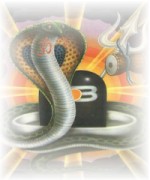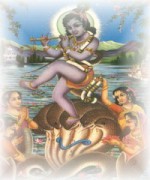| NAG PANCHAMI |
|
| Celebrated on : The fifth day of the Bright half of Shravan. | | | Religion : Hindu |
|
|
|
| On the fifth day of the bright half of Shravan people worship the snake, “nag”. The day is known as “Nag Panchami”. Naga Panchami is the festival of snakes celebrated on the fifth day of the bright fortnight in the month of Shriven. The festival falls during the rainy months and is believed to counter the increased possibility of a snake bite during this time. People visit temples specially dedicated to snakes and worship them. Shiva temples are also favoured places for veneration as snakes are considered dear to him. In South India, people craft images of snakes using cow dung on either side of the entrance to the house to welcome the snake god. Some go to worship the snake which is believed to be hiding in the holes of anthills. Or else a five hood snake is made by mixing “gandh” (a fragrant pigment), “halad-kumkum” (turmeric powder), “chandan” (sandal) and “keshar” (saffron) and placed on a metal plate and worshipped. This practice of worshipping the snake on this day is related to the following story. |
|
The Snake and the Farmer :-
A farmer was ploughing his field. At the edge of the field there was an anthill which he inadvertently destroyed with the plough, and thus the young serpents that were hiding in it were killed. The mother snake had casually gone out. When she came back she could not find her young ones. At last she found them cut into pieces. She was furious and understood that the farmer had killed them. She was bent on taking revenge. |  |
|
|
| At night when the farmer was sleeping with his wife and children, the snake came full of anger. She began to bite the feet of the farmer, and then one by one the feet of his wife and children. All began to cry. But the eldest daughter happened to be out of the house that night. Then the snake remembered that on the occasion of her wedding, the girl had gone to the house of her father-in-law. “I will not spare her either,” the snake resolved. |
|
| The snake ran towards the neighbouring village. She stopped before the door of a house, and saw a young girl inside. She recognized her as the farmer’s eldest daughter. The snake went in determined to bite her. But then she saw the young girl with joint hands worshipping the snake she had made out of “gandh”, and the nine “nagkule” (young snakes). She had offered them “nagane” (gram soaked and parched), “lahya” (rice blown out by parching), and “durva” (grass sacred to Ganpati), and she was praying with great devotion, “O God Snake, don’t be angry if I have committed any mistake. Accept my worship. Look after my people at home and in my father-in-law’s house. Do not bite anyone. Forgive any fault we may have committed inadvertently.” |
|
| With this the snake was pleased and came before the girl. She opened her eyes and got frightened at the sight of the snake. But the snake said, “Don’t be afraid. I shall not bite you. Tell me who you are and where your house is.” Then the snake knew well that the girl was the farmer’s daughter and felt very sorry for having killed all her people. |
|
| The snake told the girl what had happened, but told her not to cry. She gave her some nectar and told her to sprinkle it on her dead people, and with this they all came back to life. |
|
 | Krishna and the Kaliya Snake
Nag Panchami is also connected with the following legend of Krishna. Young Krishna was playing with the other cowboys, when suddenly the ball got entangled in the high branch of a tree. Krishna volunteered to climb the tree and fetch the ball. But below the tree there was a deep part of the river Yamuna, in which the terrible snake Kaliya was living. Everybody was afraid of that part of the river. |
|
|
| Suddenly Krishna fell from the tree into the water. Then that terrible snake came up. But Krishna was ready and jumping on the snake’s head he caught it by the neck. Kaliya understood that Krishna was not an ordinary boy, and that it would not be easy to overcome him. So Kaliya pleaded with Krishna: “Please, do not kill me.” Krishna full of compassion asked the snake to promise that henceforth he would not harass anybody. Then he let the snake go free into the river again. |
|
| On Nag Panchami day the victory of Krishna over the Kaliya snake is commemorated. For this reason Krishna is known as “Kaliya Mardan”. Snakes are believed to like milk. As this is the day of the serpents, devotees pour milk into all the holes in the ground around the house or near the temple to propitiate them. Sometimes, a small pot of milk with some flowers is placed near the holes so that the snakes may drink it. If a snake actually drinks the milk, it is considered to be extremely lucky for the devotee. The festival is celebrated with much enthusiasm by all, especially women. |
|
| As most rivers in India are in spate during the month of Shriven, poisonous snakes come out of their subterranean abodes and creep about in plenty all over the place. Many also float on flooded rivers running through the countryside. Mortality from snakebites must have been considerable to prompt people to worship the nagas to seek protection from them. Because of the fear, nagas were elevated to a divine status by the Hindus. The serpents are believed to have the capability to change their shape at will. When in human form, they are depicted as beautiful women and handsome men. |
|
| Naga Panchami is observed indifferent ways in different parts of India. It is one of the most ancient fasts, and finds mention in the Puranas. It is believed to be one of the most auspicious days of the entire year. According to the Bhavishya Purana, when men bathe the snakes called Vasuki, Takshaka, Kaliya, Manibhadra, Airavata, Dhritarashtra, Karkotaka and Dhananjaya with milk on the fifth day of the bright fortnight of Shriven, they ensure freedom from danger for their families. |
|
| In some parts of southern India, figures of snakes are drawn with red sandalwood paste on wooden boards, or clay images of snakes coloured yellow or black are purchased. These are then worshipped and offered milk. Snake charmers wander about with all sorts of snakes, to which people offer milk. The snake charmers are paid some money for allowing this Serpent worship developed gradually from the fear of serpents that must have taken a heavy toll on life, particularly at the beginning of the rainy season. In the Ashvalayana Grihyasutra, the Paraskara Grihyasutra and other Grihyasutras, a rite called Sarpabali or 'offerings to serpents' was performed on the full moon night of Shriven. However the reason that it was moved from the full moon night to that of the fifth night of the bright fortnight is not apparent. It may be due to the slight change in the time of the onset of the rains. |
|
Tags:Nag Panchami Puja, Naag Panchami Festival Puja in India, Naga Panchami Puja Shravan, Nag Panchami Puja Celebration,nag panchami sms,nag panchami pooja, nag panchami 2010, nag panchami 2010 date, nagpanchami,festivals,nag panchami,nag panchami images,nag panchami 2010,nag panchami messages,nag panchami, nag panchami 2010, nag panchami 2010 date, nag panchami story, nagpanchami sms,nag panchami pooja, nag panchami 2010 date, nag panchami, nag panchami 2010, nag panchami sms
source:http://www.aryabhatt.com


No comments:
Post a Comment